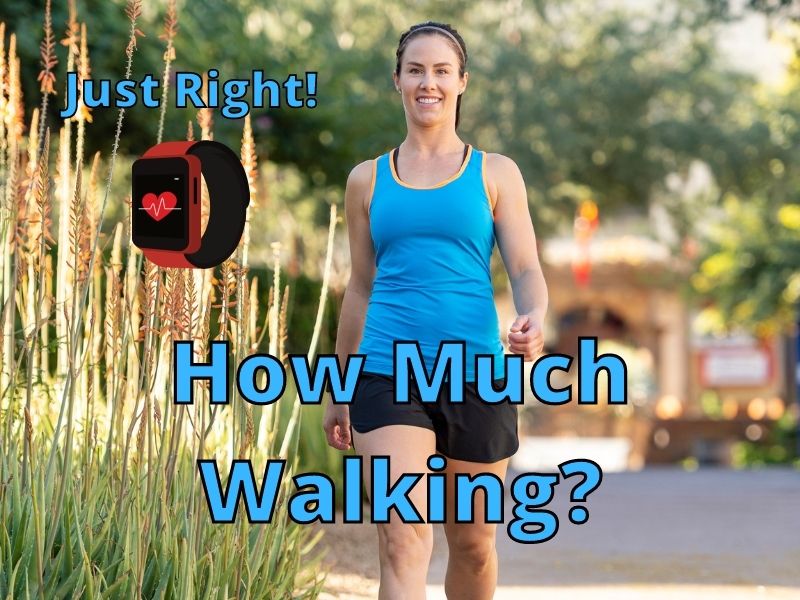I went walking last weekend and spent about 30 minutes walking. This is my normal amount when I walk each time I go out, but I don’t use it as exercise. I use running, resistance training, and weights for exercise.
When you use walking to exercise, you need to get your heart rate up most of the walk. Walk 1.4 miles in 22 minutes each day or 2 miles in 30 minutes for 5 days. It will add up to the 150 minutes of moderate exercise recommended by the American Heart Association.
Walking is a good low impact exercise that most people can do almost every day. You’ll need to monitor your heart rate and how you are breathing to ensure you are exercising at a moderate pace. Soon you will get some great exercise with your brisk walks.
Find a Comfortable Place
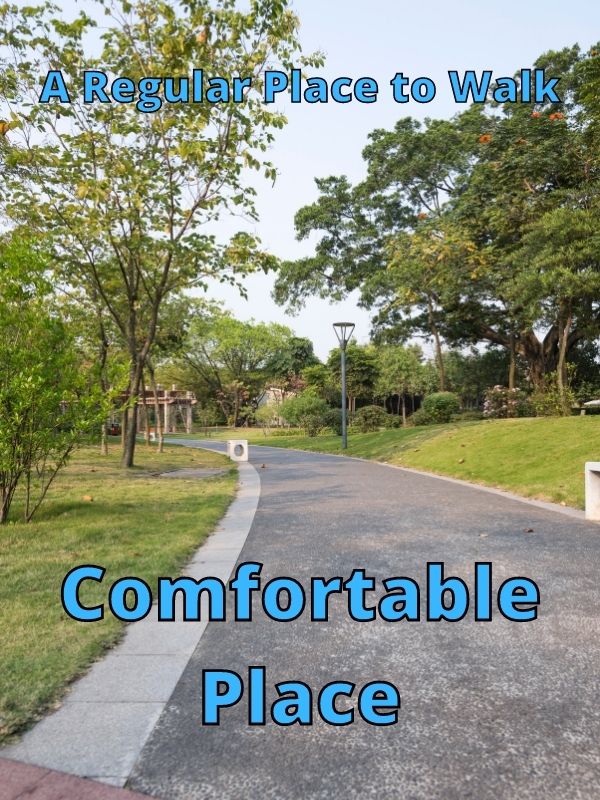
When I walk I prefer a quiet location. I enjoy walking on trails or sidewalks with low traffic. I can think, relax, and focus on music or a podcast I’m listening to.
There’s nothing better than to get out and walk for a while. You start to feel better and more energetic. It helps to find a low-traffic area or trail that you can walk on regularly so you feel comfortable in that environment.
Try a couple of places near where you live to test out. If they are busy during the day, try in the early morning. I can’t find many people out when I go running at 6 am in the morning.
With some comfortable clothing and shoes, you’ll be able to enjoy your time outside and get the exercise you want.
Once you’ve found a comfortable place, you can start your weekly walking routine and establish your exercise program. You’ll find out what times and routes are best for your exercise plan. After a couple of weeks, you may also start to see some of the health benefits of walking.
Increase Your Walking Speed Over Time

If you are walking about 150 minutes a week, you’re on your way to a healthy weekly exercise routine. The next step in the process is to increase the speed of your walking so that your heart rate is consistently higher during your walks.
Raising your heart rate should occur slowly over the course of several weeks to months. Each person is different and will need more or less time to get used to a raised heartbeat for extended periods.
It’s best to use your first week of 150 minutes of walking to test yourself and see about how much walking at a fast pace you can do.
On your first day try walking quickly for five minutes and then walk normally. Does your heart because slow down quickly or slowly. If it takes a long time for your heart rate to slow down, 5 minutes is probably just about how much your body can handle right now.
If your heartbeat returns to around normal in about 1 minute then you might want to try another 5 minutes of fast walking. If your heartbeat takes 2 minutes or more minutes to return to normal then try walking about 5 minutes again on the next day if your body is ready.
You can also transition over an 8 week period. Walk fast for about 3.75 minutes each time you walk for the first week. Then each additional week add another 3.75 minutes of fast walking. You’ll end up at 30 minutes of fast walking at the end of eight weeks.
It should look something like the chart below.
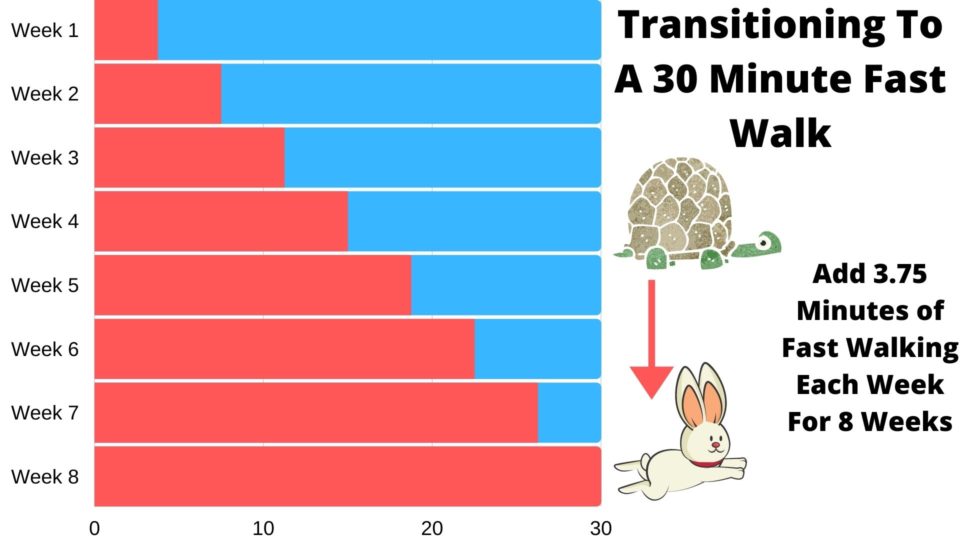
| Week 1 3.75 Minutes | Week 2 7.5 Minutes | Week 3 11.25 Minutes | Week 4 15 Minutes | Week 5 18.75 Minutes | Week 6 22.5 Minutes | Week 7 26.25 Minutes | Week 8 30 Minutes |
|---|
Be sure to check your heart rate after each fast walk to see how long it takes to return to normal. If your heart rate takes more than a minute to return to normal you should probably stay at about the same amount of fast walking time you have been doing.
If your heart just doesn’t seem to recover for long periods, consider lowering your fast walking time.
Once you have determined about how long you can walk at a moderate rate, stay at that pace for at least one week. The next week increases the time by whatever is reasonable for you. You never want to push yourself too hard if you’re not ready.
Another way to see how hard your heart is working is to use a heartrate monitor. Buying a smartwatch can help you keep your heart rate in the correct range for your age. The chart below can help you find the approximate rate for you.
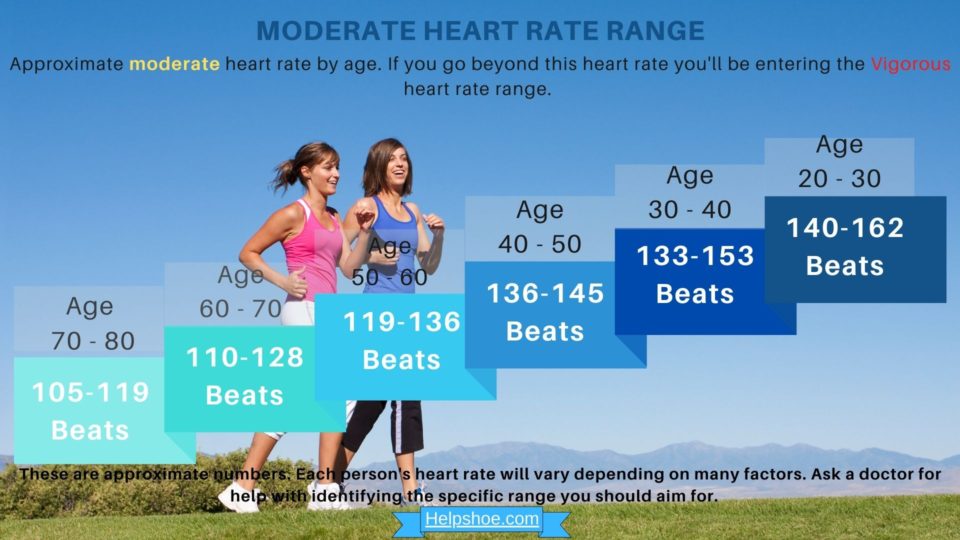
Getting 150 Minutes of Moderate Exercise
How Far Do I Walk?
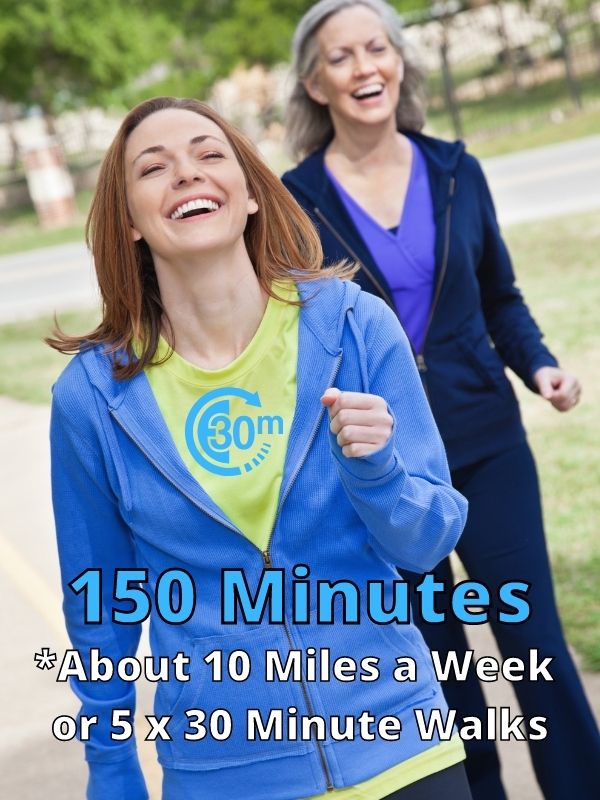
For many people walking at a fast pace will feel unnatural. It takes some getting used to. For the average person, walking at about 2.5 mph – 3.0 mph is probably normal. A fast pace might be 4 mph.
While each person is different, you can guess that it will take about 2 miles to fast walk for 30 minutes at a pace of 4 mph. If you are going out five times a week you would cover about 10 miles during the 150 minutes of weekly walking.
If you would rather walk each day and end up with 150 minutes of moderate exercise, you would need to walk about 22 minutes each day to cover 10 miles a week.
Therefore the right amount of exercise each week would be to fast walk about 2 miles five times a week or about 10 miles each week.
Of course, we are all different and have different bodies and are of different ages, so this is a rough estimate of what is helpful if you were to only use walking as exercise.
Get Walking Shoes and Exercise Clothing

While it won’t be necessary to using walking shoes or exercise clothing when you first start your walks, over time you will want them. They make moderate exercise more comfortable and the shoes are generally better for your joints.
When I don’t have the right gear, exercise sometimes becomes too uncomfortable and I just can’t work out the way I want.
A running shoe or a cross-trainer can work as your walking shoe, but you might want to try out a walking shoe because they are designed to help you walk.
Some walking and running shoes can be interchangeable, meaning they can be used for either activity. Make sure the shoe you choose fits what you need for your feet and body.
If you pronate or supinate you can find shoes that help your feet feel better and have the support they need.
If you’re not sure what to look for, check out my downloadable checklist for what a walking shoe should have.
It makes a big difference for me when I walk in the right shoes and exercise in the right clothing. I feel comfortable, my knees don’t hurt, and I remain warm or cool because of the exercise clothing I am using. Then I am able to get in more exercise because I feel good.
Keep Motivated For Weeks and Months

It’s one thing to start walking as a way to exercise, it’s quite another to keep it up for longer periods. The key is to find the things that motivate you best.
Here are some ways to get and keep motivated on your journey for a healthier body:
- One way most people feel motivated is through feelings of accomplishment. To feel you’re making progress use a checklist or exercise planner to mark each time you walk and give yourself a little praise.
- Take it slow. If you can’t go out for 30 minutes, just get dressed and go for a minute. Why? You’re establishing a routine that will carry you through the hard times and the good times.
- Have a mission statement or specific purpose. Write out your purpose and place it somewhere you will see it so you can read it. It might say, “I am walking 150 minutes each week because ________. Read and reinforce why each day so when you have no motivation you can feel at least a hint of purpose, and make at least a small effort.
- See yourself as succeeding, even if you don’t see any progress. You need to feel good about yourself and you can remind yourself that health goals take a long time to achieve. Sometimes you never see much change on the outside, even though lots of changes are going on internally with your body.
- Understand why you make excuses and which fears stop you from exercising. I can make many excuses for why I shouldn’t exercise but are there really any? If I think hard enough I can always find a way to exercise.
- Discomfort is usually the main reason I avoid exercise 99% of the time. It takes time, energy, and sometimes physical discomfort.
- I find that if I adopt the attitude of not thinking about it and just doing it, I feel much better during my exercise experience. Focusing on discomfort brings me down and creates a barrier to getting my workout done.
Learn the Right Fast Walking Techniques
To walk fast isn’t too hard but we can learn to make it more effective and less impactful on our joints by carefully adjusting how we move.
For some people, it’s best to continue walking the say way they always have been but just faster. Once you start walking faster for longer periods you may naturally start to adjust how you walk to make it more efficient.
Here are some steps to help you adjust to fast walking.
First, you want to make sure you are walking correctly at a slow pace. You may not have noticed how your feet are pointing or if you are landing hard on your heels. Check out this article to learn about clues to start focusing on improved foot placement when walking.
Next, get the best shoes necessary to best support your foot type. Focus on walking in the shoes you will be wearing most days. Get two pairs and alternate if possible, to help the foam decompress after exercise.
Then, work on increasing your pace over time. You may need to learn some speed walking techniques to help you reduce the impact on your joints. It all depends on how fast vigorous walking is for you.
Last, take your time to get it right. Sometimes fast walkers straighten their legs too much and jamb their heels into the ground with each step. Your knees need to have some bend to absorb foot impacts. Alternatively, you could jog slowly instead of speed walking if walking fast is too difficult to get used to.
Final Thoughts
Walking for 30 minutes a day can be an enjoyable experience. I recommend an exercise partner, finding great places to walk, and listening to some music to make the exercise one you’ll want to repeat over and over.
Take your time to do things at your own pace so you can keep up a consistent routine. Once it’s a habit, you’ll likely continue to make it a daily part of your life and couldn’t think to be without it.
Good luck on your walking exercise journey and thanks for visiting Helpshoe.com

